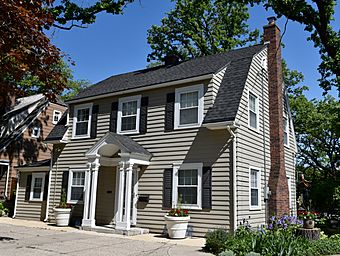Forest Park Historic District facts for kids
Quick facts for kids |
|
|
Forest Park Historic District
|
|

Simon Fox House (1935)
|
|
| Location | Roughly bounded by Willow Cr., Crescent & Linden Drs., State St., S. Pierce & N. Taylor Aves., 1st St. SW., Mason City, Iowa |
|---|---|
| Area | 55 acres (22 ha) |
| Architectural style | Late 19th & early 20th century American movements Late 19th & early 20th century Revivals Modern movement |
| NRHP reference No. | 14001167 |
| Added to NRHP | January 20, 2015 |
The Forest Park Historic District is a special neighborhood in Mason City, Iowa. It's recognized across the country as a historic district because of its unique buildings and history. It was officially added to the National Register of Historic Places in 2015.
This district is mainly a residential area, meaning it's full of homes where people live. It's located just west of Mason City's main downtown area.
Contents
What Makes Forest Park Special?
When the Forest Park Historic District was listed, it included 403 different buildings and structures. Out of these, 291 are considered "contributing buildings." This means they help show why the district is historically important. Most of these are houses (201 of them), and the rest are garages (90). There are also 112 buildings that are not considered "contributing."
The homes in Forest Park range from one to two-and-a-half stories tall. Some of the larger homes can be found on streets like Crescent, Linden, and Beaumont. Most houses have foundations made of brick or tile. Their outside walls are usually made of wood, though some are made of brick.
Popular Home Styles
You can see many different architectural styles in Forest Park that were popular in the early to mid-1900s. Some of the most common styles include:
- Prairie School
- American Craftsman
- Tudor Revival
- Colonial Revival
- Modern
Many of these houses were built using designs from special pattern books or catalogues.
How the Neighborhood Grew
The Forest Park area was first planned out between 1912 and 1916. Building homes there started slowly in the 1910s. However, from the 1920s until the early 1940s, the neighborhood grew steadily. After World War II, most of the empty lots had been filled, so new construction slowed down.
Street Layout and Trees
The streets on the west side of the district are laid out in a straight grid pattern, like a checkerboard. But on the east side, the streets curve and wind. The neighborhood is also known for its many trees, which create a large, leafy canopy. These trees are planted in people's yards and along the streets.
Notable Homes
One special home in the district is the Tessa Youngblood House, built in 1922. It is so important that it is also individually listed on the National Register of Historic Places.



